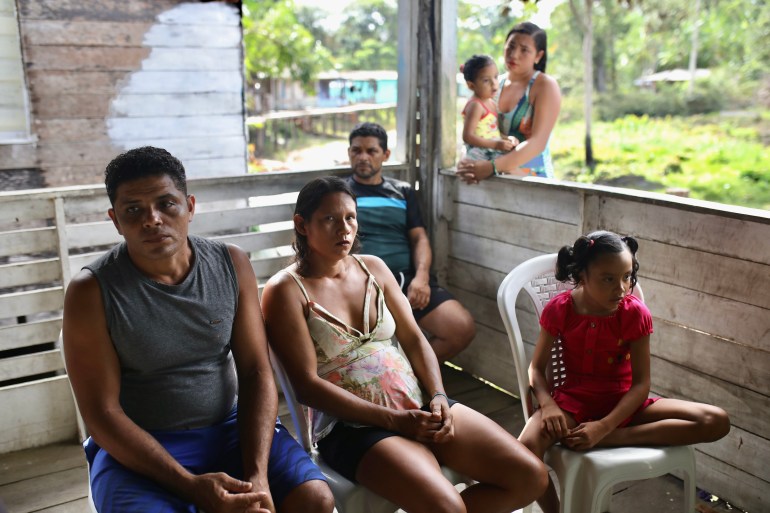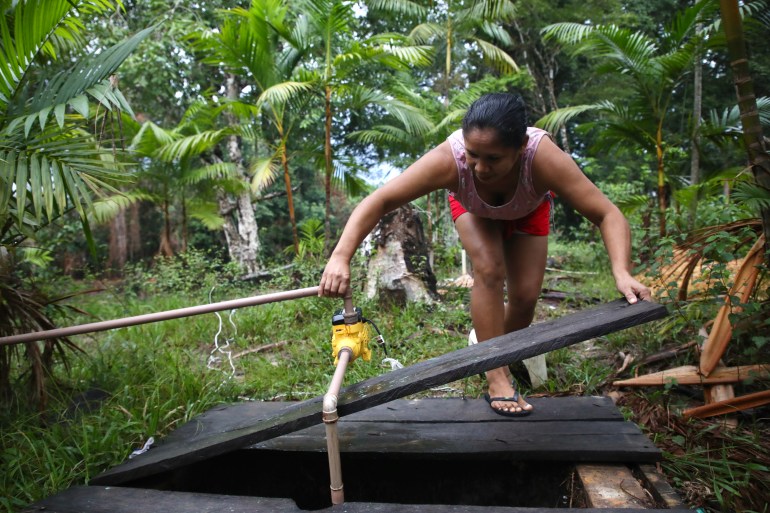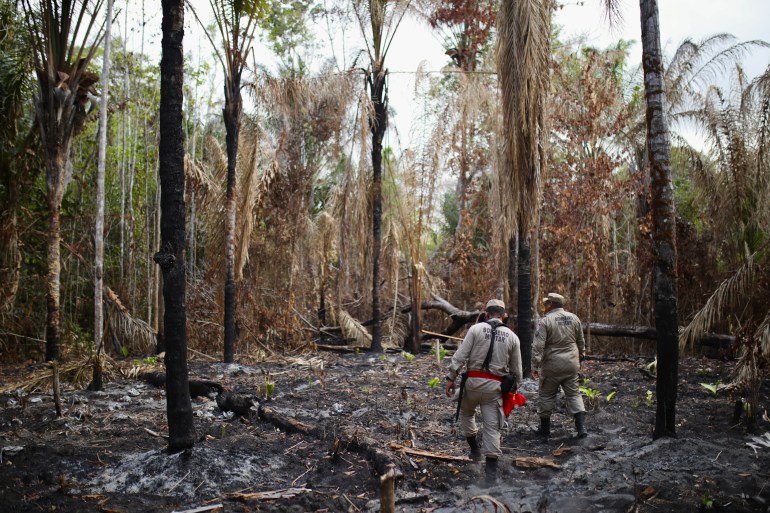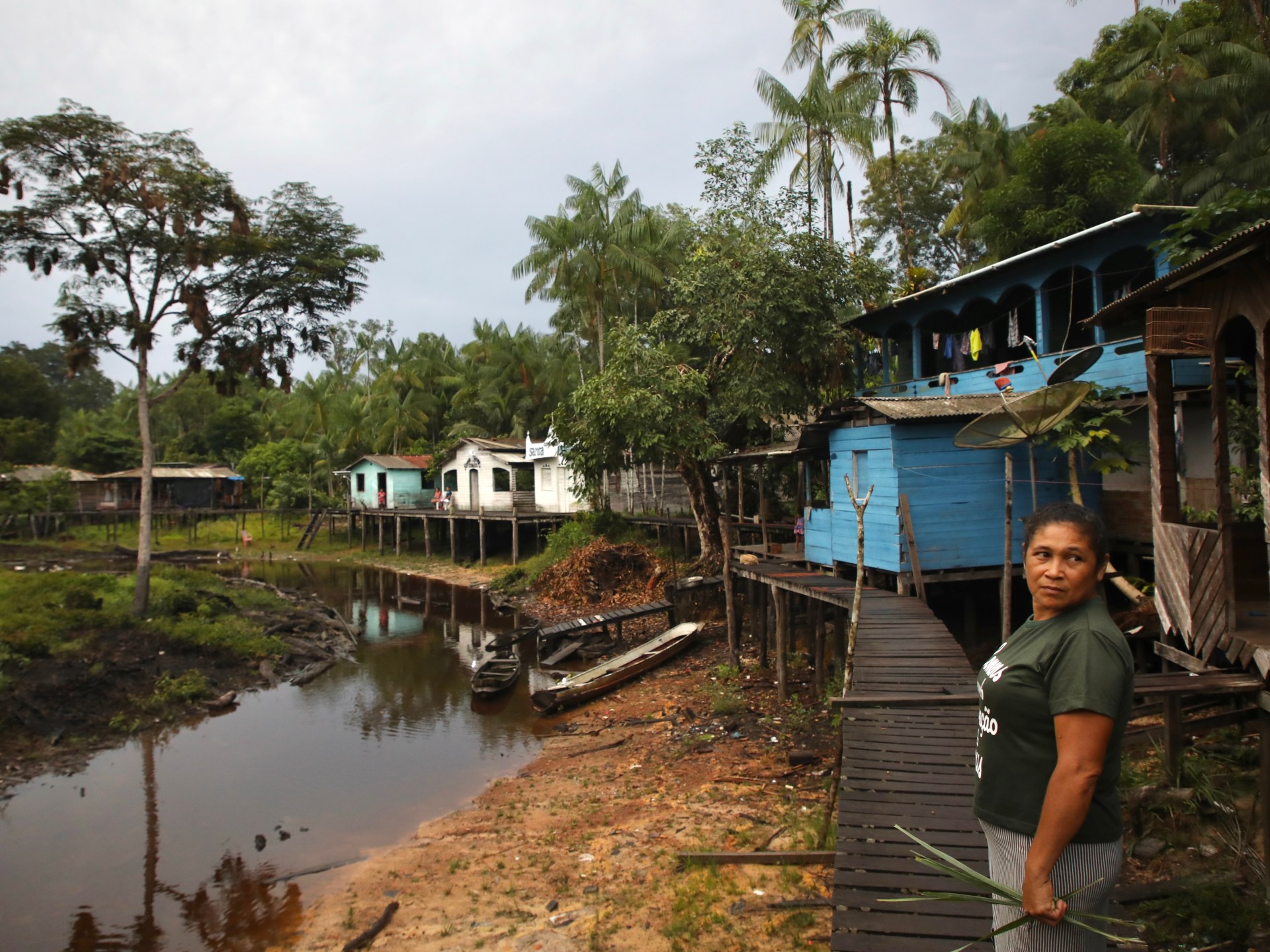Curralinho, Brazil – For communities on the Brazilian island of Marajó, the ebb and flow of the Canaticu River marks the turn of the seasons.
During the rainy months, the river is several metres deep, lapping below the wooden houses that rise from its shores on stilts. Residents rely on its water for drinking, cooking and washing.
But when summer hits, the river dwindles to a stream. Still, its flow is normally sufficient for locals to meet their daily needs.
This year, however, a severe drought has engulfed large swaths of Brazil’s Amazon rainforest. All that remains of the Canaticu River in some areas is a dark brown trickle, laden with bacteria and almost completely dried up.
“Now we cannot use it for anything. It wasn’t like this before,” said 36-year-old Elizete Lima Nascimento, who has lived in one of the riverside communities, Serafina, for the past decade.
The dry conditions have sparked a crisis in towns like Serafina — one that could transform their way of life for generations to come.

Hundreds of thousands of people rely on the Amazon’s rivers and streams for food, transportation and income.
But the historically low water levels have forced residents to reimagine their relationship to the environment. One tributary, the Rio Negro, plunged to levels not seen in 121 years.
“We are completely dependent on nature,” Maria Vanessa Tavares de Souza, a 36-year-old teacher who lives in Serafina, said during a community meeting to discuss the problems caused by the drought.
“Now that climate change has unbalanced everything, it’s going to be hard for us to survive here.”
Already, one of the residents’ primary food sources is threatened: fish. Some have been left stranded as the river recedes — and in the water that remains, the corpses of other fish float to the surface.
Abnormally warm temperatures are suspected in the mass die-off. Residents fear the dead fish could pollute the water as they decompose.
Nine heatwaves have hit Brazil since the beginning of the year, with the heat index in Rio de Janeiro soaring to almost 60 degrees Celsius (140 degrees Fahrenheit) in November. Worldwide, 2023 is expected to be the hottest year on record.

Scientists have blamed climate change, driven by the burning of fossil fuels, for the rising temperatures and extreme weather conditions.
This year’s El Niño — a climate phenomenon that warms surface waters in the equatorial Pacific region — has been particularly intense, contributing to the Amazon’s drought.
But the trend towards drier weather has been a long time coming. A string of harsh summers already led many Serafina residents to dig wells in their backyards to access subterranean water, instead of relying on the river.
Others have called for the installation of a drinking water distribution system, a major infrastructure project that would consist of pipes and storage facilities. They argue the wells are unreliable and cannot stand in for a long-term solution.
Still, well owners like Nascimento say their homemade water systems have been pivotal to withstanding the drought.
“The well is extremely important. We use its water for everything — for drinking, cooking, making açai, washing both ourselves and our clothes,” she said, as she lifted the wooden planks in her garden to reveal the six-metre-deep hole.
Not every family has a well, though, so residents that do own one share their water supplies with neighbours. Paula Lima, 43, brings home more than 50 litres (13 gallons) a day from a well at her cousin’s house on the other side of the community, just to meet her family’s needs.
The trips have contributed to Lima’s back problems. But she has no choice. Consuming the river’s water when its level is so low triggers vomiting and diarrhoea — if not worse.

Eleniuda Costa Paiva de Souza, a 30-year-old nurse, recently had to take her two-year-old daughter to the nearest hospital — a trip that required trekking across the jungle, then travelling five more hours by boat. Her child had become ill after ingesting the river’s sludge.
De Souza said she intends to leave the community shortly. “Life here is only going to get worse. In town, things will be easier,” she explained.
Isolation is part of life for riverine communities: Serafina hugs a serpentine bend in the river, surrounded by rainforest as far as the eye can see. But the weak flow of the Canaticu River has made Serafina even more secluded.
To stock up on supplies, locals normally use the river to travel to nearby towns. But with the water so shallow, residents are forced to manoeuvre their small wooden boats at a snail’s pace to avoid logs and exposed roots.
Many worry that, if a medical emergency were to occur, it would take too long to reach the closest town.
Downriver, at the mouth of the Canaticu, the municipality of Curralinho has faced its own struggles amid the severe drought.
Located on the southern coast of Marajó, the town and its population of nearly 34,000 saw fires tear through thousands of hectares of nearby rainforest in November.
Curralinho was not alone in contending with raging flames. In the first two weeks of October, more than 2,900 blazes erupted in the state of Amazonas, a record number.
The smoke was so thick that it choked the region’s biggest city, Manaus, complicating navigation and the delivery of essential supplies.
Criminal enterprises have also taken advantage of the dry conditions to clear the rainforest with fire, as part of land-grab schemes.

But in Curralinho, small-scale farmers were largely responsible for the blazes. They use fire as a crop management tool, to remove the remnants of the previous year’s harvest and neutralise the soil’s acidity.
The tinder-dry conditions, however, led some of the fires to roar out of control.
The town had declared a state of emergency as early as September, warning of heightened fire risk during the drought.
Precipitation in the Amazon had been below average for at least six months prior. One of the long-term causes is deforestation: Rainforests soak up and release moisture, helping to generate cycles of rainfall. But without the densely packed trees, the humidity drops, meaning less rain.
“Ten to 15 years ago, these fires weren’t a problem. The forest used to be more humid, which meant the flames would not propagate,” said Ezaquiel Pereira, who works for Curralinho’s environmental department.
Machinery to prepare the soil for planting could stop farmers from starting the blazes. But that equipment can cost about $25,000, Pereira added.
For farmers like 65-year-old Maria Terezina Ferreira Sampaio, such an expense is out of the question.

Sampaio lives on the outskirts of Curralinho with her husband in a small, bare wooden house where she bought up five children. The couple depend on the sale of crops to complement their retirement stipends, allowing them to buy food, medicine and clothes.
This year, the drought devastated their orange, coconut, lemon and banana trees and impeded their cassava plants from growing to an edible size.
“I’ve been crying and crying. After so much sacrifice…” Sampaio’s words trailed off, as she looked in despair at the parched ground, dry leaves crackling beneath her feet.
Despite their best efforts, hundreds of people have had their crops wiped out due to the lack of rain, said Curralinho’s environmental secretary Esmael Lopes.
On a regional scale, the worst of the drought could still lie ahead, as El Niño tends to intensify in December before petering out in April or May.
In Curralinho, sharp bursts of rain this month have lifted spirits and provided hope of relief from the dry spell. But even if wet weather were to come now, it would be too late, Sampaio said.
“We should already be harvesting. Instead, everything is dead,” she said.
Sumber: www.aljazeera.com
 Skip to content
Skip to content

